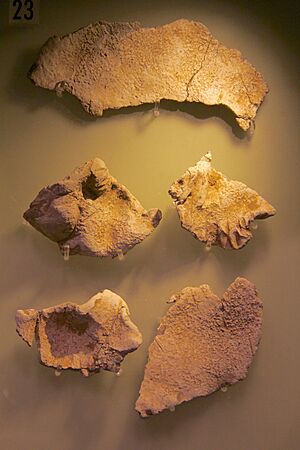Huxley Hoard facts for kids
Quick facts for kids Huxley Hoard |
|
|---|---|

The Huxley Hoard at the Museum of Liverpool
|
|
| Material | Silver |
| Period/culture | Viking |
| Discovered | Huxley, Cheshire, 2004 |
| Present location | Museum of Liverpool |
The Huxley Hoard is a special collection of Viking silver jewelry. It was found buried near Huxley in Cheshire, England. This amazing find dates back to around 900-910 AD. It includes 21 silver bracelets, one silver ingot (a bar of metal), and 39 pieces of lead. Together, these items weigh about 1.5 kilograms.
The bracelets were folded flat when they were found. Many of them have cool designs. Sixteen bracelets have patterns made by punching. Six have crosses stamped in the middle. Another six have crosses in the middle and at each end. Some have special patterns like lattices, hourglass shapes, or zig-zags. Four of the bracelets are plain. The pieces of lead found with the hoard suggest it might have been buried in a lead sheet or a wooden box lined with lead.
Contents
What is the Huxley Hoard?
A hoard is a hidden collection of valuable items. People often bury hoards to keep them safe from enemies or thieves. The Huxley Hoard is a treasure from the Viking Age. It helps us learn about the Vikings who lived in England a long time ago.
Where Did the Hoard Come From?
Historians believe the silver bracelets might have been made by Norse settlers. These were Vikings who had settled in Dublin, a city in Ireland. The hoard was probably buried for safekeeping. This happened when Viking refugees moved into Cheshire and the Wirral area in the early 900s. They might have buried their valuables to protect them during uncertain times.
How Was the Hoard Discovered?
The Huxley Hoard was found by a man named Steve Reynoldson. He discovered it in November 2004. Steve was using a metal detector when he found fragments of lead about 30 centimeters underground. This exciting discovery led to finding the rest of the silver hoard.
Where Can You See the Huxley Hoard?
The Huxley Hoard is one of several hoards found in the Chester area. After its discovery, it was first kept at the British Museum. Then, in 2007, it was shown at the Merseyside Maritime Museum. A special grant of £45,000 from the Heritage Lottery Fund helped buy the hoard. Now, it is owned by three groups: the Grosvenor Museum, Cheshire Museums Service, and National Museums Liverpool. You can see this amazing Viking treasure on display at the Museum of Liverpool.
See also


